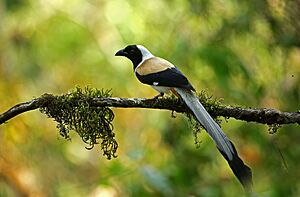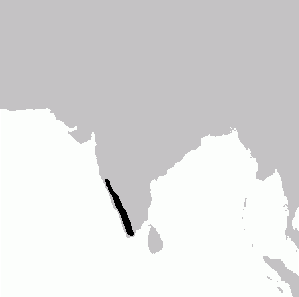White-bellied treepie facts for kids
Quick facts for kids White-bellied treepie |
|
|---|---|
 |
|
| Conservation status | |
| Scientific classification | |
| Genus: |
Dendrocitta
|
| Species: |
leucogastra
|
 |
|
The white-bellied treepie (scientific name: Dendrocitta leucogastra) is a beautiful bird that belongs to the crow family. You can only find this bird in the forests of southern India. It sometimes lives in the same areas as another bird called the rufous treepie, but it's easy to tell them apart by how they look and the sounds they make.
Contents
What Does the White-bellied Treepie Look Like?
This bird is easy to spot because of its white head and body. It prefers to live in thick forests. You won't often see it near people's homes, unlike the rufous treepie.
The white-bellied treepie is about 48 centimeters (19 inches) long. The back of its neck is white. Its throat and chest are black.
Its upper legs are black, and the feathers under its tail are a reddish-brown color, like chestnuts. The rest of its belly is white.
The bird's back is a lovely chestnut-brown. Its wings are black and have a clear white patch. The area above its tail, called the rump, is also white.
The two longest feathers in its tail are silver-grey for most of their length. The very end of these feathers is black. All the other tail feathers are completely black. The bird has a black beak and greyish-black legs.
Where Does the White-bellied Treepie Live?
You can find the white-bellied treepie in the forests of the Western Ghats mountain range. This area is mainly south of a city called Goa in India.
There have been a few rare sightings outside this main area. These include places like Erimalai and parts of Andhra Pradesh. However, some older reports from central India are not certain.
How Does the White-bellied Treepie Behave?
The white-bellied treepie eats many different things. Its diet includes fruits, seeds, and flower nectar. It also enjoys eating insects and other small creatures without backbones.
Sometimes, it will hunt for small reptiles and rodents. It even eats the eggs and baby birds from other nests.
When this bird calls out, it often bows its head and lets its wings droop down. You might see several treepies gather in one tree. They will call loudly many times, especially during the breeding season. This usually happens from April to May, right before the monsoon rains. Some birds might even start nesting in February.
The treepie builds its nest like a platform. It uses small twigs and places the nest in a medium-sized tree. The female bird usually lays three eggs. These eggs are greyish and have green and grey spots.
White-bellied treepies often join other birds to find food. They are frequently seen with birds like the greater racket-tailed drongo.
Images for kids
-
Illustration by John Gould attached to his species description






